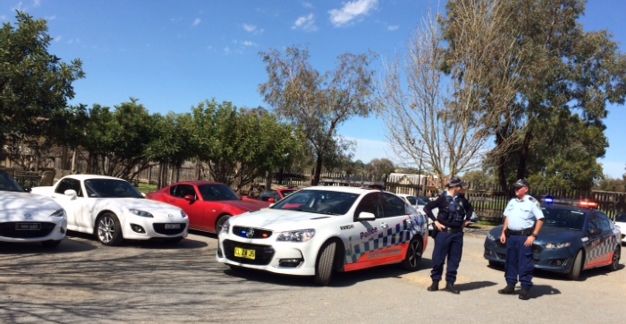A Run to the Historic Railway Town of Junee
02 October 2017 / Text: Bob Judd, Photos: Bob Judd and Bricet Kloren
To escape the overwhelming heat of Canberra’s hottest September day EVER, 10 cars left for the even warmer climes of the railway town of Junee. Despite a few drips and drops of rain when we left, the weather was perfect for our relaxed two-day trip which took in the spectacular canola-filled fields of the area around Binalong, Harden, Cootamundra, Junee and home via Gundagai.
Three months ago, when we planned this excursion, we were told of a new coffee shop that was opening in Binalong. Canberra travellers well know that there is no decent coffee about an hour out of the Capital, so the news of a new venue was eagerly anticipated and built into our plans for this excursion. Unfortunately, they didn’t make it in time. Something to do with ‘the damn council’ and unconnected sewerage pipes. We called in to say G’Day, but had to travel on to Harden to get a coffee.
The backroads took us to lunch at E’Claire’s Café at Cootamundra – a venue that never fails to satisfy. The short trip down the Olympic Highway, under the watchful eyes of several members of the Constabulary, got us to Junee with time to visit the Junee Railway Station.
Junee is a Railway Town in the true sense of the word. The town didn’t exist until it was decided to build an overnight stop for the long journey between the capitals of the two Colonies of Victoria and New South Wales. Situated half way between Melbourne and Sydney, the French Renaissance-style station was opened in March 1885, after the first station burnt down. Even today, the Railway Station and its incorporated Refreshment Rooms is a most impressive complex of Heritage listed buildings. Our arrival at the station coincided with the arrival of the XPT train heading to Sydney. I think our group of 10 cars was more impressive!
Witnessed again by our Friends in Blue, we slowly moved off to meet our appointment at the Railway Round House Museum for our guided tour. Built in 1947 to provide employment for returning soldiers, the turntable, at 100 foot, was the largest in the Southern Hemisphere and was built to service virtually every class of steam and diesel Locomotive, rail car and XPT in NSW.
Today, half the Roundhouse is still used for commercial reconditioning and the rebuilding of locomotives. The other half has operated as a museum since 1994 and now has a significant collection of locomotives and rolling stock, which includes an 1891 Z24 locomotive in full working order. Our Guide on the day, Keith Ison, was knowledgeable and friendly and gave us ample time to clamber on and over all the exhibits on display. Very BIG Boys Toys!
We stayed the night at the very comfortable Crossing Motel and fine-dined in their restaurant. Their selection of beers and local wines was enthusiastically tested by our group without any complaints of inadequacy.
Next morning, at a gently suitable time, we went straight to the other major attraction in Junee, the Licorice and Chocolate Factory for a top-class breakfast / brunch. Here you can also visit the Gasworks Garage, which houses the local historic car club’s collection of dusty and rusty relics.
Whilst casually eating our breakfasts, we noted the arrival of three Highway Patrol cars and, thinking that we were seeming to attract a lot of interest from our Friends in Blue, we invited them in to look at our cars and have some photos taken. It seems they were down from Windsor for some unspecified reason and we noted their rather obvious presence. They assured us they weren’t chasing us, despite the common journey we seemed to be taking. After some good-natured banter and photo taking, we asked them which way they were going so we could go the other way. Funnily enough, we didn’t see them again.
After buying vast quantities of licorice, and chocolate, and gifts from the gift shop, we started off for home. We travelled the pretty little road from Junee to Gundagai and saw the first of the anticipated brightly coloured Cootamundra wattle we’d expected to see over the weekend.
At Gundagai, we paused to continue our Railways theme by visiting the 1902 wooden Railway Bridge. At 812 metres it sits parallel to the wooden Prince Alfred Bridge which formed part of the Hume Highway until it was replaced in 1976. The Prince Alfred Bridge was built in 1866 and is the longest timber viaduct in Australia. Both bridges are classified by the National Trust for preservation as being historically important.
At this point, we parted ways, with some heading south and others heading home via Jugiong for a cuppa. We had a good collection of cars for our run, covering all 4 models, and an RF to complete the set. Funnily, there were 6 white cars out of the 10 (if you include the Ceramic ND). What happened to every car being red?
Our thanks to everyone who came along and put up with my ceaseless briefing sessions.







